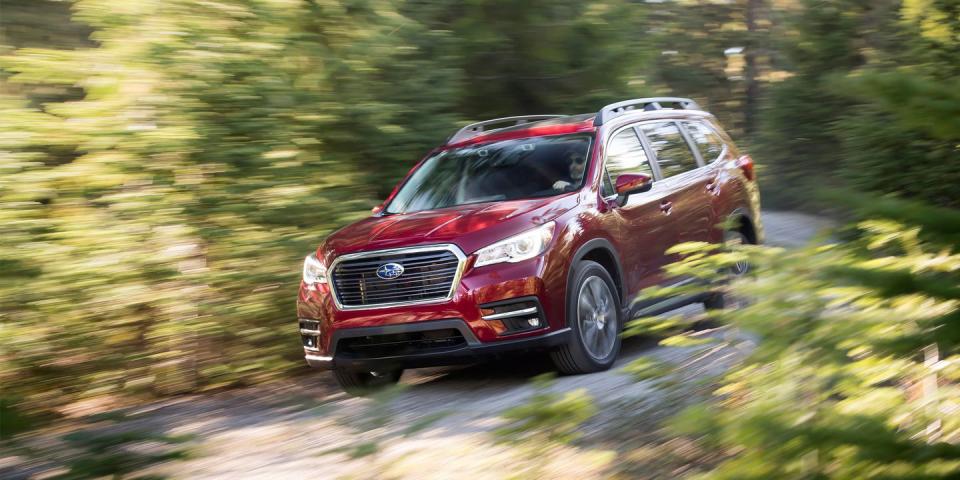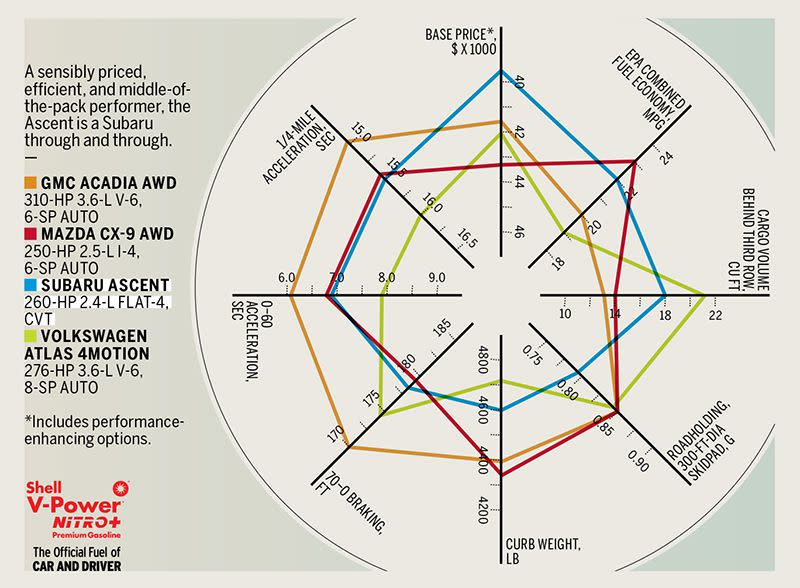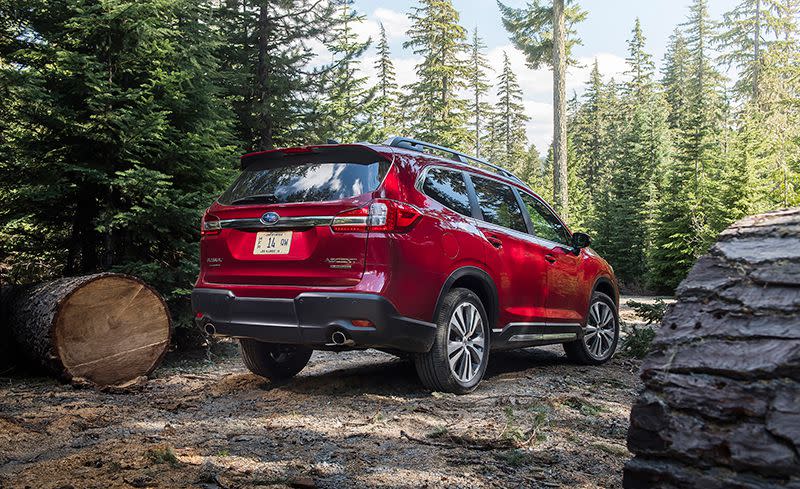2019 Subaru Ascent Limited

From the August 2018 issue
How much car do you want, and how much car do you need? It’s a nearly impossible distinction to parse, and the automakers like it that way. They make more money if you buy more car than you need, and most of us do exactly that. Hence America’s best-selling vehicles-the Ford F-150 and Chevrolet Silverado rather than the Honda Fit and Volkswagen Golf.
Subaru has exploited this imprudence as deftly as any brand. In recent years, it has transcended its humble roots as a small, offbeat automaker with an unconventional customer base by convincing an ever larger number of people that not only do they want all-wheel drive, plastic body cladding, and extra ground clearance, they need this stuff. Sure, not all of it is strictly necessary for the daily commute, but what if someday you just want to take a spontaneous camping trip into the wilderness, with all the dogs, in the middle of a snowstorm? The company wants you to believe that you need a Subaru. This is what is known as good marketing.
Three-row SUVs play a similar game. Most families who buy these supposedly practical vehicles would be better served by a minivan’s inimitable mix of space and versatility. But who wants to be seen in a minivan? The irrational appeal of crossovers is both visual and ideological, and has caused this now crowded segment to absolutely dwarf minivans in terms of sales.
Subaru is set to double down on the want-need duality with the new, 2019 Ascent. Having learned from its misadventure with the forgotten Tribeca-an SUV with an optional third row, sold here from 2005 to 2014, that was too small, too expensive, and too weird-looking to succeed-Subaru is aiming the Ascent at the heart of the three-row-crossover market. Like such well-established models as the Ford Explorer, Honda Pilot, Mazda CX-9, and Toyota Highlander, the Ascent is an unabashed minivan surrogate. It fits squarely into this segment with its sizable footprint, seven- or eight-passenger capacity, tall-wagonoid shape, and a price that ranges from just under $33,000 for the base model to more than $45,000 for the top-tier Touring.
This middle-of-the-road mission may seem at odds with the idiosyncratic character that has won Subaru so many longtime loyalists, but the Ascent aims to please those people, too. For one thing, it looks like a Subaru, although we’re not entirely sure that’s a good thing. It doesn’t take much squinting to see the Ascent as an overinflated, awkwardly proportioned Outback-Forester mash-up. The design team played it safe on this one, a decision that’s admittedly tough to fault when the brand is setting sales records in the United States nearly every month.
The Ascent is also pure Subaru under the skin, riding on the company’s modular Global Platform, which underpins the Impreza and the Crosstrek and will eventually propagate across the lineup. Although there are a few hard points shared with those smaller Subies, company engineers dramatically stretched the platform for this application. Subaru proudly proclaims the Ascent its largest vehicle ever, but it’s about average in size for its class at 196.8 inches long, 71.6 inches tall, and 76.0 inches wide. It weighs 4600 pounds, a few hundred more than the class featherweights but a bit less than the portliest ones, such as the Dodge Durango and VW Atlas.
Nonetheless, excellent packaging gives the Ascent one of the more accommodating cabins in its segment. The second row, available with either a three-place bench or a pair of captain’s chairs, is both capacious and flexible. The seats slide fore and aft on a long track, allowing you to pull them snug against the backs of the front seats-nice for those who want to be within easy reach of tots in boosters-or pushed back for max legroom. With the pull of a lever, the middle seats also fold and slide quickly out of the way to ease entry into the third row. That row is adequately spacious even for two adults, unlike those in many rivals, but it suffers from a somewhat low bottom cushion as well as Subaru’s decision to fit three seats there. Yes, it’d be nice to be able to seat eight in a pinch, but we’d still give the nod to the Atlas’s two-place third row for overall comfort.
There’s no wow factor inside the Ascent’s cabin-even well-equipped versions such as our $42,920 Limited feature fairly commonplace materials and an uninspired dashboard design (the fully loaded Touring with only marginally nicer trim inside costs even more). But thoughtful details abound. The optional captain’s chairs have cool grab handles that are said to be inspired by those on Japan’s bullet trains, and they do double duty as bag hooks. The lid of the underfloor storage compartment, behind the third row, can be Velcroed to the back of the rearmost seats to stay open, and the compartment can accommodate the optional removable cargo shade when it’s not in use so it doesn’t take up room in your garage. So Subaru sells you clutter, plus a place to put it.
The Ascent’s new turbocharged 2.4-liter flat-four makes 260 horsepower and 277 pound-feet of torque and is another example of Subaru’s efforts to maintain its quintessential traits while eliminating the characteristic weaknesses that might turn off new converts. Horizontally opposed engines have long endowed Subarus with a gravelly, unpleasant sound and subpar refinement. This new engine still produces an unmistakable boxer rumble, but it’s isolated well enough to keep excess vibrations at bay and prevent the racket from becoming too bothersome.
Subaru’s continuously variable automatic transmission, newly revised for this application, comes standard and is a good partner for this engine. It’s one of the few CVTs we’ve sampled that somewhat convincingly executes simulated shifts as you accelerate, mitigating the droning sensation that can exaggerate a boxer engine’s inherent lack of civility. Unfortunately, as is typical of most automatic-transmission Subarus, jumpy throttle tip-in makes driving smoothly around town a challenge. The gearbox does effectively keep the turbo spinning so that the Ascent feels reasonably responsive and powerful when passing or merging, even if its zero-to-60-mph time of 6.9 seconds is almost a second slower than those of its quickest V-6 rivals. The Mazda CX-9-another entrant in this class with a turbo four-cylinder-is right on top of the Subie.
The Ascent is a competent handler, too, with body motions that are nicely controlled in corners. Its light steering lacks feel and feedback, removing any sense of engagement from the equation, but it’s accurate enough, and only the comparison-test-winning CX-9 really provides much driving joy in this segment, anyway. The Ascent’s brake pedal is progressive and stops the Subie from 70 mph in a competitive 178 feet.
Ride quality is not what we’d call plush. Instead, the Ascent sits at the tauter, sportier end of this segment, although the tense ride might settle down a bit with a full load of people and/or cargo onboard. Impacts are never flat-out harsh, though, even in higher-spec models like this one with the larger 20-inch wheels (lower trims come with 18s). At highway speeds, the Falken all-season tires start to sing, and they could only hold on for 0.79 g around the skidpad.
Of course, buyers of three-row SUVs typically care more about a different set of figures, and that is a numbers game Subaru plays expertly. The Ascent is class competitive in nearly every objective measure. Its EPA-rated fuel economy is near the top of the segment, and it averaged a respectable 20 mpg while in our care. It tows up to 5000 pounds. Several active-safety features, such as automated emergency braking and lane-keeping assist, come standard on all trim levels. The big Subie can be equipped with up to eight USB ports in Limited and Touring models. Android Auto and Apple CarPlay also come standard on all models. A whopping 19 cupholders are aboard. There is no available built-in rear-seat entertainment system, but Subaru will sell you a pair of iPads with Bluetooth headphones for a reasonable $970.
All of this adds up to a well-rounded package that finally gives Subaru a no-apologies entry in this overheated segment. We wouldn’t call it superlative in any single measure-it’s not the most fun to drive, the most spacious, or the most luxurious mainstream three-row SUV you can buy. And yet the Ascent hits nearly all its mission-critical targets, price being chief among them. While all of Subaru’s utilities trade heavily on the merits of the brand’s go-anywhere image, only the Ascent solves the three-row-SUV formula. You know you want one.
Competitors

You Might Also Like

 Yahoo Finance
Yahoo Finance 



